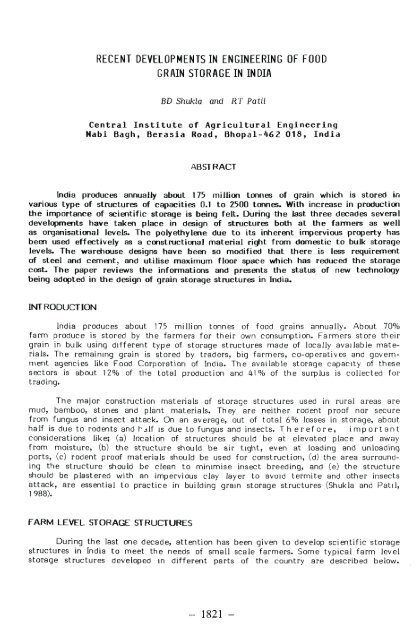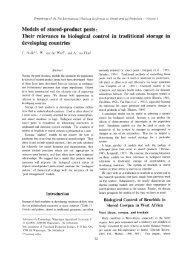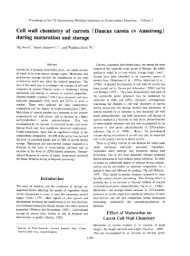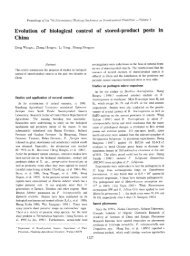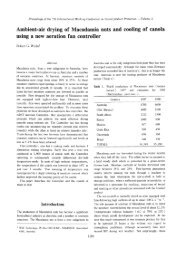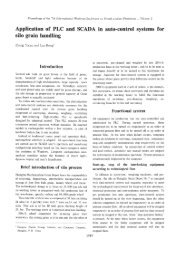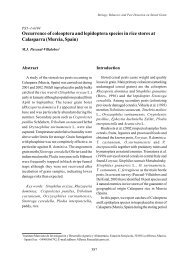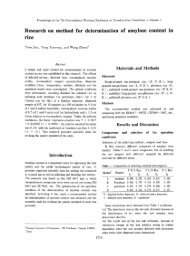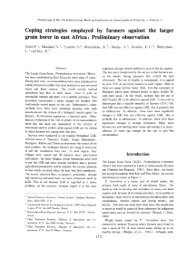recent developments in engineering of food grain storage in india
recent developments in engineering of food grain storage in india
recent developments in engineering of food grain storage in india
Create successful ePaper yourself
Turn your PDF publications into a flip-book with our unique Google optimized e-Paper software.
RECENT DEVELOPMENTS IN ENGINEERING OF FOOD<br />
GRAIN STORAGE IN INDIA<br />
BD Shukla and RT Patil<br />
Central Institute <strong>of</strong> Agricultural Eng<strong>in</strong>eer<strong>in</strong>g<br />
Nabi Bagh, Berasia Road, Bhopal-462 018, India<br />
ABSTRACT<br />
India produces annually about 175 million tonnes <strong>of</strong> gra<strong>in</strong> which is stored <strong>in</strong><br />
various type <strong>of</strong> structures <strong>of</strong> capacities 0.1 to 2500 tonnes. With <strong>in</strong>crease <strong>in</strong> production<br />
the importance <strong>of</strong> scientific <strong>storage</strong> is be<strong>in</strong>g felt. Dur<strong>in</strong>g the last three decades several<br />
<strong>developments</strong> have taken place <strong>in</strong> design <strong>of</strong> structures both at the farmers as well<br />
as organisational levels. The polyethylene due to its <strong>in</strong>herent impervious property has<br />
been used effectively as a constructional material right from domestic to bulk <strong>storage</strong><br />
levels. The warehouse designs have been so modified that there is less requirement<br />
<strong>of</strong> steel and cement, and utilise maximum floor space which has reduced the <strong>storage</strong><br />
cost. The paper reviews the <strong>in</strong>formations and presents the status <strong>of</strong> new technology<br />
be<strong>in</strong>g adopted <strong>in</strong> the design <strong>of</strong> gra<strong>in</strong> <strong>storage</strong> structures <strong>in</strong> India.<br />
INT RODUCTION<br />
India produces about 175 million tonnes <strong>of</strong> <strong>food</strong> gra<strong>in</strong>s annually. About 70%<br />
farm produce is stored by the farmers for their own consumption. Farmers store their<br />
gra<strong>in</strong> <strong>in</strong> bulk us<strong>in</strong>g different type <strong>of</strong> <strong>storage</strong> structures made <strong>of</strong> locally avaIlable materials.<br />
The rema<strong>in</strong><strong>in</strong>g gra<strong>in</strong> is stored by traders, big farmers, co-operatives and government<br />
agencies like Food Corporation <strong>of</strong> India. The available <strong>storage</strong> capacity <strong>of</strong> these<br />
sectors is about 12% <strong>of</strong> the total production and 41 % <strong>of</strong> the surplus is collected for<br />
trad<strong>in</strong>g.<br />
The major construction materials <strong>of</strong> <strong>storage</strong> structures used <strong>in</strong> rural areas are<br />
mUd, bamboo, stones and plant materials. They are neither rodent pro<strong>of</strong> nor secure<br />
from fungus and <strong>in</strong>sect attack. On an average, out <strong>of</strong> total 6% losses <strong>in</strong> <strong>storage</strong>, about<br />
half is due to rodents and r"df IS due to fungus and <strong>in</strong>sects. Th erefore, important<br />
considerations like; (a) location <strong>of</strong> structures should be at elevated place and away<br />
from moisture, (b) the structure should be air tight, even at load<strong>in</strong>g and unload<strong>in</strong>g<br />
ports, (c) rodent pro<strong>of</strong> materials should be used for construction, (d) the area surround<strong>in</strong>g<br />
the structure should be clean to m<strong>in</strong>imise <strong>in</strong>sect breed<strong>in</strong>g, and (e) the structure<br />
should be plastered with an impervious clay layer to aVOId termite and other <strong>in</strong>sects<br />
attack, are essential to practice <strong>in</strong> build<strong>in</strong>g gra<strong>in</strong> <strong>storage</strong> structures (Shukla and Patil,<br />
1988).<br />
FARM LEVEL STORAGE ST RUCTURES<br />
Dur<strong>in</strong>g the last one decade, attention has been given to develop scientific <strong>storage</strong><br />
structures <strong>in</strong> India to meet the needs <strong>of</strong> small scale farmers. Some typical farm level<br />
<strong>storage</strong> structures developed In different parts <strong>of</strong> the country are described below.<br />
- 1821 -
<strong>of</strong> surface water. The entire structure IS made <strong>of</strong> RCC except the floor. The floor constructIOn<br />
consists <strong>of</strong> two layers <strong>of</strong> cement concrete. A thick layer <strong>of</strong> bitumffl is also<br />
provided <strong>in</strong> between these layers. A coat<strong>in</strong>g <strong>of</strong> bitumen is provided on the exterior side<br />
<strong>of</strong> the wall for mOisture pro<strong>of</strong><strong>in</strong>g. The structure has been found sUitably air tight and<br />
as a result, one fumigation serves the purpose for 33 months <strong>storage</strong> <strong>of</strong> wheat (Fig. 2).<br />
BULK STORAGE OF FOOD GRAIN<br />
The ma<strong>in</strong> agencies Involved <strong>in</strong> large quantity <strong>storage</strong> <strong>of</strong> <strong>food</strong> gra<strong>in</strong>s for a longer<br />
period are: (a) The Food Corporation <strong>of</strong> India [FCn, (b) Central Warehous<strong>in</strong>g Corporation<br />
[CWC); (c) State Warehous<strong>in</strong>g Corporation [SWC), (d) Gra<strong>in</strong> Market<strong>in</strong>g Cooperatives [GMC],<br />
and (e) Some State Government AgenCies<br />
Several type <strong>of</strong> <strong>storage</strong> systems are followed In India depend<strong>in</strong>g on the length <strong>of</strong><br />
<strong>storage</strong> and prodUct to be stored. Some <strong>of</strong> them are mentioned below.<br />
Cover and Pl<strong>in</strong>th Storage<br />
This IS an ImprovIsed arrangement <strong>of</strong> stor<strong>in</strong>g <strong>food</strong> gra<strong>in</strong>s <strong>in</strong> open, generally on a<br />
plInth, whIch is damp and rat pro<strong>of</strong>. The gra<strong>in</strong> bags are stacked In a standard size on<br />
wooden dunnage. The stacks are covered from all four sides and top with 250 micron<br />
LOPE sheets. Food gra<strong>in</strong>s <strong>in</strong> this system are generally stored for 6-12 months.<br />
Community Storage Structures<br />
Bulk <strong>storage</strong> structures <strong>of</strong> higher capacity are termed community <strong>storage</strong>. They are<br />
maCle from remforced bricks, corru'gated galvonised Iron or alum<strong>in</strong>ium sheets <strong>in</strong> capacities<br />
rang<strong>in</strong>g from 25 to 75 t (Birewar, 1985).<br />
Godowns (Bag Storage Structures)<br />
These are primarily meant for provid<strong>in</strong>g warehous<strong>in</strong>g facilIties to the farmers. The<br />
godowns, 100 t to 5000 t capacity, are owned by Govt. agencies. The features <strong>of</strong> some<br />
<strong>of</strong> the Important types <strong>of</strong> structures as shown <strong>in</strong> Fig. 3 are given below (Mathur, 1986).<br />
Tw<strong>in</strong> Span Warehouse With Structural Trusses<br />
ThiS design was adopted <strong>in</strong> early Sixties and constructed with brick or stone masonary.<br />
Asbestos or corrugated GI sheets supported by steel trusses are used for ro<strong>of</strong><strong>in</strong>g. Due<br />
to provision <strong>of</strong> valley gutters, there IS perennial problem <strong>of</strong> leakage result<strong>in</strong>g In damage<br />
<strong>of</strong> stored gra<strong>in</strong>.<br />
Flat RCC Ro<strong>of</strong> Warehouse<br />
To overcome the disadvantage <strong>in</strong> earlier deSign, subsequently the RCC flat type<br />
ro<strong>of</strong> structure was developed to store about 5000 t <strong>of</strong> gra<strong>in</strong>. The cost <strong>of</strong> construction<br />
<strong>of</strong> such structures IS excessIvely higher due to applIcation <strong>of</strong> steel and cement and it<br />
takes a long tIme <strong>in</strong> constructIon.<br />
Warehouse With Wooden Trusses:<br />
This type <strong>of</strong> design was found economical In hilly region where good quality wood<br />
is available m plenty. The stored products are safe if the structures have been placed<br />
away from moisture.<br />
- 1824 -
Transit Storage Shed<br />
These are multlspan sheds constructed on a elevated ground wIth nom<strong>in</strong>al phnth<br />
height <strong>of</strong> 4.9 m from floor level. The side walls are made <strong>of</strong> GI Sheets. This design IS<br />
simple and very useful for rural <strong>storage</strong>, because <strong>of</strong> low constructional cost.<br />
Conventional Wanflouse<br />
This design has been standardised for stor<strong>in</strong>g 5000 t <strong>of</strong> gra<strong>in</strong>. The walls are made<br />
<strong>of</strong> brick/stone or concrete mansonary and ro<strong>of</strong> <strong>of</strong> asbestos sheets is supported over RCC<br />
columns.<br />
Modified Cooventional Warmouse<br />
The design <strong>of</strong> the conventional warehouse has been modIfied for sav<strong>in</strong>g <strong>of</strong> steel<br />
and cement. The use <strong>of</strong> mIld steel has been replaced by the cold tWisted deformed steel.<br />
Th e number <strong>of</strong> compartments are also reduced. Th e angle iron trusses are replaced With<br />
tubular trusses as they are lighter <strong>in</strong> weigh compared to steel trusses. The greatest advantage<br />
<strong>in</strong> this design is that no Intermediate columns are provided to hold the structure<br />
as s<strong>in</strong>gle span ro<strong>of</strong> serves the purpose. This gives maximum utilisation <strong>of</strong> space Without<br />
any obstruction.<br />
The comparison <strong>of</strong> consumption <strong>of</strong> steel <strong>in</strong> trusses <strong>of</strong> different deSigns for 5000<br />
t capacity is given <strong>in</strong> Table 1.<br />
The cement and steel are two important raw materials In construction <strong>of</strong> the warehouses,<br />
hence, it is essential to economise their use. ScientIfic design has reduced the<br />
use <strong>of</strong> steel and cement by 60%. Use <strong>of</strong> high tensile steel for re<strong>in</strong>forcement and tubular<br />
trusses, cold rolled sections for ro<strong>of</strong> purl<strong>in</strong>es has brought down the requirement <strong>of</strong> steel.<br />
Th e use <strong>of</strong> cement has also been reduced due to application <strong>of</strong> under reamed pile foundation<br />
and elim<strong>in</strong>ation <strong>of</strong> base concrete for floors. The comparative cemen·t and steel consumption<br />
<strong>in</strong> various structures In India is given <strong>in</strong> Table 2.<br />
The aUeways i.e., operational area IS provided In the structures for handl<strong>in</strong>g <strong>of</strong><br />
gra<strong>in</strong> bags, stack<strong>in</strong>g and <strong>in</strong>spection <strong>of</strong> gra<strong>in</strong> stocks. The reduction In space IS done by<br />
elim<strong>in</strong>at<strong>in</strong>g <strong>in</strong>termediate concrete columns and provid<strong>in</strong>g large s<strong>in</strong>gle span ro<strong>of</strong> trusses.<br />
The percentage <strong>of</strong> alleways <strong>in</strong> different types <strong>of</strong> designs has been shown In Table 3.<br />
The f<strong>in</strong>al impact <strong>of</strong> improv<strong>in</strong>g the design <strong>of</strong> structure is on the cost <strong>of</strong> <strong>storage</strong>.<br />
The cost <strong>of</strong> construction <strong>of</strong> different designs evolved so far is given <strong>in</strong> Table 4.<br />
LARGE SCALE MODERN STORAGE STRUCTURES<br />
Silos are used on large scale for bulk <strong>storage</strong> <strong>of</strong> oil seeds and cereals by the Government<br />
or procur<strong>in</strong>g agencies. The silos are constructed out <strong>of</strong> concrete or metal. Metal<br />
silos are cheaper than concrete silos by 15-20% depend<strong>in</strong>g on their size. Generally Silo<br />
system is equipped with other preparatory units hke clean<strong>in</strong>g and dry<strong>in</strong>g equipment. Under<br />
Indian condition <strong>in</strong>itially silos are 50% more expensive but this additional cost is recovered<br />
With<strong>in</strong> 2-4 years. The loss <strong>of</strong> gra<strong>in</strong> <strong>in</strong> such system is only 0.2% compared to 1% <strong>in</strong> godown<br />
and warehous<strong>in</strong>g systems. The loss caused by rodents, <strong>in</strong>sects, fungi and handhng is about<br />
0.2% compared to 8% <strong>in</strong> godown system (Sawant, 1"985).<br />
- 1827 -
CONCLUSION<br />
India produces about 175 million tonnes <strong>of</strong> <strong>food</strong> gra<strong>in</strong> annually but the post productIOn<br />
losses are also high I.e., In order <strong>of</strong> 10% and out <strong>of</strong> that 6% are dur<strong>in</strong>g <strong>storage</strong>. Major<br />
stock is stored at farmers level (70%) and rema<strong>in</strong><strong>in</strong>g at organisational level. The importance<br />
<strong>of</strong> scientific <strong>storage</strong> has been very well realised <strong>in</strong> the country and many advances<br />
have taken place <strong>in</strong> development <strong>of</strong> structures at farmers as well as agency level. The<br />
efforts at farmers level had been to develop low cost structure with locally available<br />
material and could be constructed at rural level. At organisatIonal level, the design <strong>of</strong><br />
structures have been modified <strong>in</strong> such a way that the requirement <strong>of</strong> steel and cement<br />
has been m<strong>in</strong>imised. It also facilitates maximum utIlisation <strong>of</strong> space thereby reduc<strong>in</strong>g<br />
the overall cost <strong>of</strong> <strong>storage</strong> per tonne. The advancement In scientific design and development<br />
<strong>of</strong>. stores have been found effective as it has created Interest and awareness among<br />
farmers and traders to preserve the <strong>food</strong> gra<strong>in</strong>s safely.<br />
ACKNOWLEDGEMENTS<br />
Auth ors are th ankfu I to Mr. VG Bonde and Mr. NG Bhandarkar resp ectively for<br />
trac<strong>in</strong>g the figures and typ<strong>in</strong>g the manuscripts <strong>of</strong> this paper.<br />
REFERENCES<br />
1. Ahmad SG and SV Dwyer (1988). Ipomea cornea re<strong>in</strong>forced mud gra<strong>in</strong> <strong>storage</strong> structure,<br />
Bull. <strong>of</strong> Gra<strong>in</strong> Tech., Vol: 26(3): 197-207<br />
2. Bhattacharjee S, Sonelal and TR Boruah (1986). Development and test<strong>in</strong>g <strong>of</strong> hollow<br />
bamboo <strong>storage</strong> structures, Bullet<strong>in</strong> <strong>of</strong> Gra<strong>in</strong> Tech., Vol: 24(3): 233-239<br />
3. Birewar BR (1985). Recent develoment <strong>in</strong> <strong>storage</strong> structures <strong>in</strong>: Storage <strong>of</strong> agril.<br />
durables and semipenshables, Eds. Kachru, Bisht, Patil, CIAE, Bhopal, 90-93<br />
4. Birewar, BR (1986). Underground air tight RCC structure for <strong>storage</strong> <strong>of</strong> <strong>food</strong> gra<strong>in</strong>s,<br />
Bullet<strong>in</strong> <strong>of</strong> Gra<strong>in</strong> Tech., Vol: 24(1 );38-43<br />
5. Chouksey RG (1985). Bag and bulk <strong>storage</strong> <strong>of</strong> <strong>food</strong> gra<strong>in</strong>s at farmers level <strong>in</strong>: Storage<br />
<strong>of</strong> agnl. durables and semie-perlshables, Eds. Kachru, Bisht and Patll, CIAE, Bhopal,<br />
55-56<br />
6. Indian Petrochemicals Corporation Ltd. (IPCL) (1985). Plastlculture. Fourth Report<br />
::Jf National Committee on the Use <strong>of</strong> Plastics <strong>in</strong> Agri., Govt. <strong>of</strong> India, M<strong>in</strong>istry<br />
<strong>of</strong> Petroleum, New Delhi, p: 252<br />
7. Mackay PJ and MFS Jamieson (1970). Climate <strong>in</strong> relation to <strong>food</strong> <strong>storage</strong>, Part<br />
I, World Food Programme and Food Storage Manual, Rome, pp: 258-259<br />
8. Mathur AP (1986). Several standard designs <strong>of</strong> warehouse <strong>storage</strong> structures and<br />
related problems <strong>of</strong> ma<strong>in</strong>tenance, A paper presented In the Regional Workshop on<br />
Warehouse Management <strong>of</strong> Bag Storage <strong>of</strong> Gra<strong>in</strong>s, New Delhi, Sept. 8-17<br />
9. Sawant 50 (1985). Modern gra<strong>in</strong> <strong>storage</strong> for redUC<strong>in</strong>g <strong>storage</strong> losses In: Storage<br />
<strong>of</strong> agrd. durables and semi-perishables, CIAE, Bhopal, pp: 25-36<br />
10. Shukla BD and RT Patil (1988). Overview <strong>of</strong> gra<strong>in</strong> dry<strong>in</strong>g and <strong>storage</strong> problems<br />
In India. GASGA Executive Se,nlnar Senes No: 2, Australia, pp: 7-27<br />
- 1829 -


